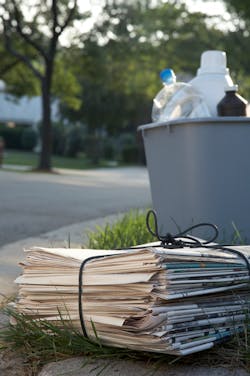A recent report on recycling in the U.S. paints a discouraging picture.
The research firm Stina Inc. reported in late April that the number of pounds of post-consumer plastics recycled in 2020 declined 5.7 percent from the previous year. That 5.7 percent decrease meant that 290 million fewer pounds were recycled. That is a lot of valuable plastic scrap that could end up in lakes, rivers, oceans and landfills.
COVID-19 was the main culprit. Many local governments stopped collecting recyclables. Other factors included low prices for virgin resin and a diminished export market.
The report was sponsored by the Association of Plastic Recyclers (APR), the Foundation for Plastic Recycling, the Recycling Partnership and the U.S. Plastic Pact. It looks at the primary post-consumer categories of recycled material, including bottles, non-bottle rigids, film and other plastics.
I live near Cleveland, Ohio, which stopped curbside pickup in April 2020, when its contract with a recycling hauler ended. Cleveland has announced that recycling will resume in June with a new service provider. That is two years’ worth of missed opportunity.
Multiply that by the other communities that discontinued picking up recyclable material, and in some locations even closed drop-off points, and it is easy to understand the 290-million-pound shortfall.
But during the pandemic, local governments continued picking up trash, repairing the streets, cleaning out storm sewers and the myriad other services we expect. So why did picking up recyclables get dropped?
All of the services performed by municipal employees are becoming more expensive. Fuel for the trucks, pay for drivers, machinery operators, technicians — you name it, and inflation is squeezing local governments. So why is picking up recyclables considered optional?
The recycling chain is cumbersome, but it starts with people putting recyclables in the correct bin and the local government picking them up and delivering them to a recycling facility. Without these steps, post-consumer material goes in oceans and lakes and landfills.
There is strong demand for recycled resin. In fact, some analysts are warning that the recycling industry won’t be able to keep up with future demand. California’s recycled-content law will require 15 percent recycled content starting later this year, 25 percent in 2025 and 50 percent by 2030.
The Independent Commodity Intelligence Services has calculated how much additional recycled resin will be needed just to meet California’s demand: An additional 800,000 metric tons of food grade PET and post-consumer PE to meet the 15 percent requirement, and a significant number of new recycling plants to meet the 2025 threshold.
Recyclers I have interviewed in the past couple of years frequently say they are maxed out on capacity. But at the same time, they have not been shy about investing in additional capacity and new technology.
“We need more supply,” said Steve Alexander, president and CEO of the Washington-based APR. “Mechanical recyclers have the capacity to process more material but lack the supply to meet current demand for post-consumer resin. Expanding and streamlining collection programs, less confusion with labeling and reducing contamination through design for recyclability should be key priorities.”
So what can plastics processors do? Long ago, we learned the value of the plastic scrap that processors had been sending to landfills. Nowadays, we reuse it or sell it to a reprocessor. Most processing plants now operate under some level of lean manufacturing, which reduces waste.
I don’t think that is enough. Plastics processors pay taxes where they live and where their plants are located. Educating local government leaders and, if necessary, applying pressure to make them understand their responsibility in the plastics recycling chain, seems necessary. If you live or work in a community that has a good plastics recycling program, campaign to get political leaders to improve and expand it.
If you live or work in a community that pays lip service to plastics recycling, it is time to attend a meeting of the county commissioners or city council to push local leaders to do more.
I would also suggest that if you hear the excuse that the community cannot break even or turn a profit on picking up recyclable plastic, you have to educate local leaders that they have a societal responsibility to do it. Their responsibility is to keep plastic waste out of landfills and waterways.
The Recycling Partnership estimates that 40 million American households do not even have access to recycling. Plastics processors can help reduce that number.
The end goal should be to clean up the environment. Making sure residents put waste plastic into the correct bin and then picking up that bin at the curb to transport to a recycling facility is a minimum first step for responsible communities.
Ron Shinn, editor
About the Author
Ron Shinn
Editor
Editor Ron Shinn is a co-founder of Plastics Machinery & Manufacturing and has been covering the plastics industry for more than 35 years. He leads the editorial team, directs coverage and sets the editorial calendar. He also writes features, including the Talking Points column and On the Factory Floor, and covers recycling and sustainability for PMM and Plastics Recycling.
